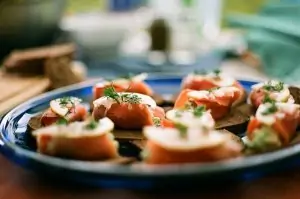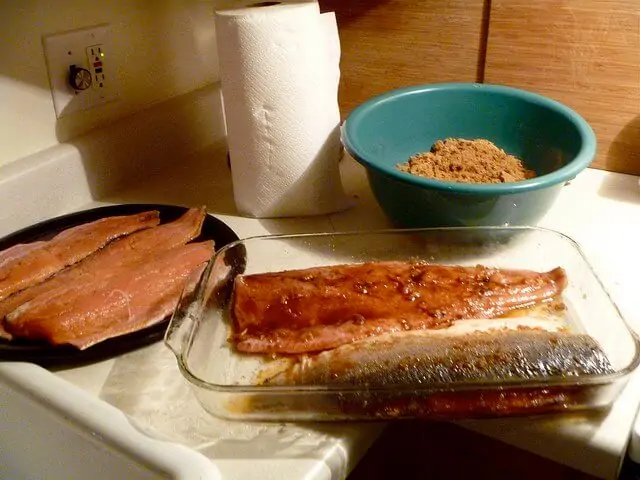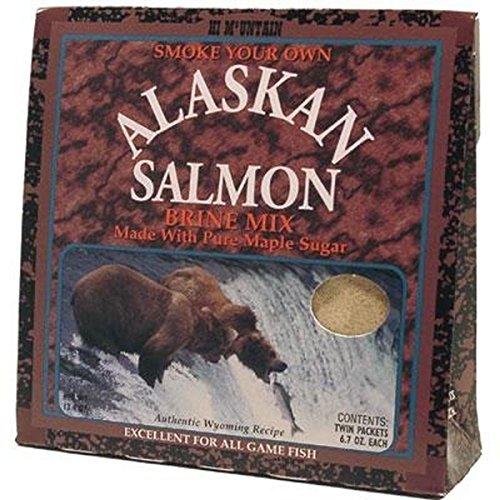
In the days before refrigeration, brining was used to preserve meat and fish. At that time, a it was necessary to add a lot of salt. Today, with our modern refrigerators, we need only add enough to do the job of retaining the moisture in smoked meat or fish.
The way brine works is simple—all meats and fish have salt. By soaking them in liquid saltier than the inside of the meat or fish, the liquid (and all those wonderful seasonings) are carried into the meat.
Brining salmon before smoking adds a dimension of flavor and moistness that compliments that delicious smoked salmon taste.
Preparing the brine
- Add enough water to cover your salmon to a pot.
- Add 4 cups brown sugar and 1 cup salt to the water. Brown sugar imparts a caramel color to the salmon, but white sugar works just as well for flavor.
- Add any other spices of your choosing and bring to a boil. (See below for some ideas.)
- Simmer for about five minutes, then remove from the heat to cool.
- Add a couple cups of ice to bring the temperature of the brine down to about 45o F.
- Add the salmon and soak overnight.
- Remove the fish from the brine. Pat dry with paper towels.
Check out Hi Mountain Alaskan Salmon Brine at Amazon
Did you know that you can brine salmon in a vacuum sealer? Read my review of the best vacuum sealer for fish and game.
Remember, the water you use is important. If you’ve got well water, use a filter pitcher. Here’s my post on the best options out there.
Spices for the salmon

Minced garlic and onion, or garlic and onion powder, are always fine spices for brining, but for salmon, some lemon pepper is almost essential.
Check out the True Lemon Pepper, Orange Ginger, & Lime Garlic Cilantro Spice Shaker Kit at Amazon
Now for the fun part. Add slices of citrus fruit for a unique taste: lemon, orange, lime. The slight citrus taste adds an exciting tang to your salmon.
Not a fan of citrus? A small handful of chopped dill in the brine works great as well.
Is your spice rack a precariously-balanced teetering tower? Organize your spices with the best drawer inserts!
Dry brine
A less messy, easier, and very different method of brining fish is the dry brine. Use the same spices as above, with about 4 cups of brown sugar and a cup of kosher salt. Add spices to taste.
Check out Domino Dark Brown Sugar at Amazon
Instead of boiling them in water, though, make sure you have enough spice mixture to coat both sides of the fish very liberally.
- Prepare a glass pan by layering aluminum foil over the bottom. Ensure it overlaps the sides enough to cover the fish when it’s in place. Next, lay plastic wrap over the foil. Have a plastic airtight container ready to hold the fish. Do not allow the brined fish to sit on the foil during its rest period or you risk a metallic taste.
- Sprinkle about a third of the dry spice mixture over the prepared pan.
- Lay the fish down on the spice mixture and use another third of the spices to coat the top side of the salmon liberally, rubbing it in gently.
- Turn the fish over and coat the other side.
- Tightly wrap the fish with the plastic wrap and foil and place it in the container.
- In about 45 minutes, the fish is brined. Remove from the wrap and thoroughly rinse off the spice mixture.
Learn about why you should be using a mortar and pestle to grind spices!
Forming a pellicle
A pellicle is a thin skin or coating that allows the smoke to adhere to the salmon during the smoking process.
To create a pellicle, remove the fish from the brine, wet or dry. Rinse, then lay the slices on racks in front of a fan to dry overnight. If this isn’t possible, layer the salmon on a rack in the refrigerator in a single layer.
If your fish is drying overnight in front of a fan, make sure it’s not directly in front of the fan. Keep the fan a few feet away so as not to make leather out of your salmon.
To perfectly smoke salmon, use a good thermometer. I found the best ones.
Smoking the salmon
The simplest of smokers makes salmon that can rival that from smokers costing many times more. Read my review of the best smoker for fish.
Simply ensure that the salmon is in a single layer and smokes from 2 to 4 hours, depending on how well done you like the salmon, and how thick the slices are.
Check out Just Smoked Salmon Western Red Alder Wood Smoking Chips at Amazon
Salmon must be cooked to an internal temperature of 145o to 165o F. Use a meat thermometer to ensure the meat is cooked to a safe temperature.
Serving the salmon
Thinly sliced smoked salmon is welcome on any type of bread, in fish dishes, or as an elegant appetizer for those special family breakfasts or dinners.
In the center of your platter, place thin slices of smoked salmon, Surround with sides of caviar, chopped hard boiled egg, lemon slices, and triangles of buttered toast. Add a bowl of a sour cream and cream cheese mixture, with chopped fresh dill and a hint of chives, a squeeze of lemon, and a bit of salt.
If you can pry your guests away from that platter for the meal, you’re lucky! Smoked salmon is truly the star of any dinner.
For more tips on smoking fish, check out this article on smoker pellets, which describes which flavors compliment various meats. You might also like this recipe for the ultimate smoked salmon.
Make your BBQ a surf and turf! Check out my favorite recipe for succulent prime rib or my comparison of USDA Prime versus USDA Choice Certified Angus Beef.
Image credit via Flickr Creative Commons: Tiberiu A. and jc.winkler.









Bryce is not a real professor, but he's real nerdy in the kitchen. He's been barbecuing, chopping, and generally blazing food for many decades. He thinks there's definitely a better spatula or utensil out there that hasn't been invented yet.